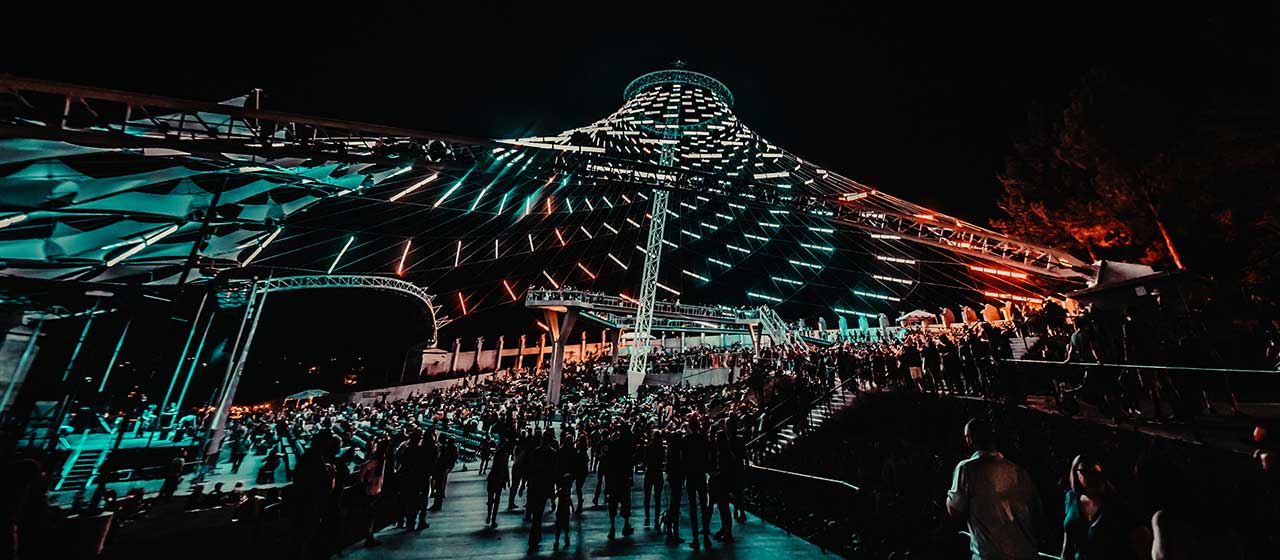Sightseeing
The City of Spokane's Riverfront Park is considered one of the most scenic urban parks in the nation. With over 64 acres to explore, much of it located on an island, you are sure to discover the magnificent Spokane Falls and River, the Expo '74 U.S. Pavilion, 1902 Clock Tower, 1909 Looff Carrousel, multiple sculptures, Centennial Trail, and inviting meadows and conservation areas. There is something to discover around every corner. Wildlife consists of ospreys, beaver, marmots, ducks, geese and occasionally deer and coyotes.
Spokane Falls

The Spokane River Falls are Spokane's finest natural attraction, as well as the heart of Riverfront Park. Located in the core of Spokane, the falls of the Spokane River flow and often rage as the seasons change. The Spokane River flows from Lake Coeur d'Alene to Lake Roosevelt and the Spokane Falls are perhaps the most dramatic transition along the 111 mile run. From the earliest of times, the Spokane Falls were a gathering place for the Spokane Tribe of Indians as a source of food and beauty. Many generations later, the falls became a gathering place for all nations with Expo '74 and is still shared daily by people from around the world.
Early settlement around the falls began in 1871 with the construction of a water driven sawmill on the south bank of the river. In 1873 the original sawmill was purchased, along with 160 acres, with the hidden intent of establishing a town. Within only a few years, the development of the City of Spokane had begun and industry began to take over the downtown riverfront. In the late 1940s the beautiful and bountiful Spokane Falls had fallen victim to industrial pollution, rail yards, and factories. By 1961 the falls industrial district had become a focus of concern and the City of Spokane adopted its first Master Plan for this area focused on urban renewal. In 1964 the city adopted the Riverfront and Great Gorge Park Development Statement which directed new urban projects to clean up and improve the riverfront area. Conceptually this ideal opened the doors for revitalization which came to fruition in the form of the 1974 World's Fair. The World Expo was focused on environmentalism and provided the perfect platform for revitalization and a green future. The newly restored Riverfront Park drew people to the falls, brought the green message and prosperity to the people of Spokane on many levels.
Today the Spokane Falls are a pristine Northwest attraction, drawing tens of thousands of spectators throughout the year. The best time of the year to view the falls is in early spring when the winter run-off rages. The best view of the falls comes from the gondola cars of the Spokane Falls SkyRide. There are several stationary viewpoints throughout the park as well. We look forward to sharing this spectacular regional treasure with you upon your next visit to the park. Don't forget to bring your camera.
Riverfront Rotary Fountain
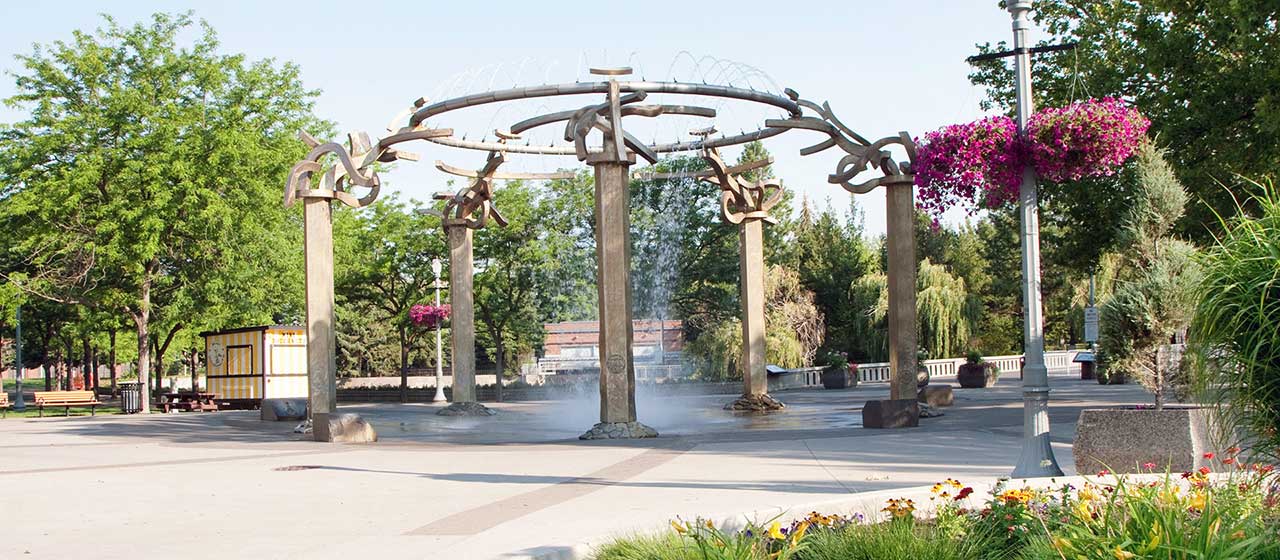
This popular water feature serves as a gateway marker for the south entrance to the park. After 13 years, the mechanical and electrical elements of the fountain were in need of repair, and the timing was ideal given the construction at the nearby Looff Carrousel and Howard Street South Bridge sites. The beloved Harold Balazs artwork is unchanged. We're adding a rock seating area around the fountain for improved safety and comfort.
Dedicated on September 1, 2005 to "the people of Spokane" and under the care of the Spokane Parks Department, the fountain is destined to be a popular attraction for many years to come. The Downtown Spokane Rotary Club 21 and the Spokane Parks Department worked together to make the fountain a reality. Financial support was also provided by numerous donors whose names appear around the fountain. Harold Balazs is the artist.
The fountain has five stainless steel columns that are 24 feet tall. These support a 30 foot diameter ring containing 40 overhead jets. The jets spray towards the middle of the fountain producing a dome of water and a waterfall in the fountain's center. Eight geysers shoot water upwards. The fountain also has dozens of mist jets, and the five boulders have jets that spray sideways. To conserve water, the fountain water is filtered and recirculated. The fountain re-opened spring 2018 along with the Looff Carrousel and Howard Street Bridge South.
The Childhood Express
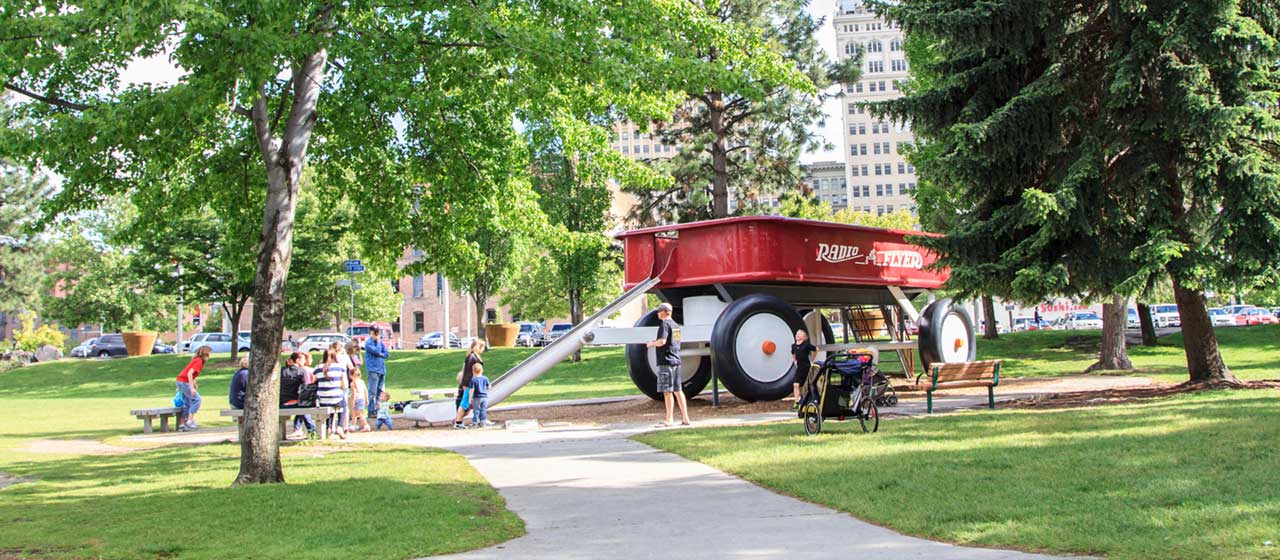
Created by artist Ken Spiering, this larger-than-life symbol of childhood is also an interactive sculpture. The handle doubles as a slide! Relax on a park bench and enjoy the beauty of the park while your kids play. Or hey, slide down the handle yourself! (We won't tell anyone...)
The Junior League of Spokane plaque, dated August 18, 1990, reads: "This sculpture is dedicated to Spokane's children, as a reflection of the past, created in the present, to last into the future."
Facts about the Red Wagon
- Created for the Centennial Celebration of Children - 1989
- Dimensions - 12' high x 12' wide x 27' long.
- Weight - 26 tons.
- Made of steel and reinforced concrete.
- Will hold as many as 300 people supporting 100 lbs. per square foot.
- 43” high edges with the rounded pinch points removed.
- Curbing ranges from 6' to 10' away from the sculpture itself.
Clock Tower
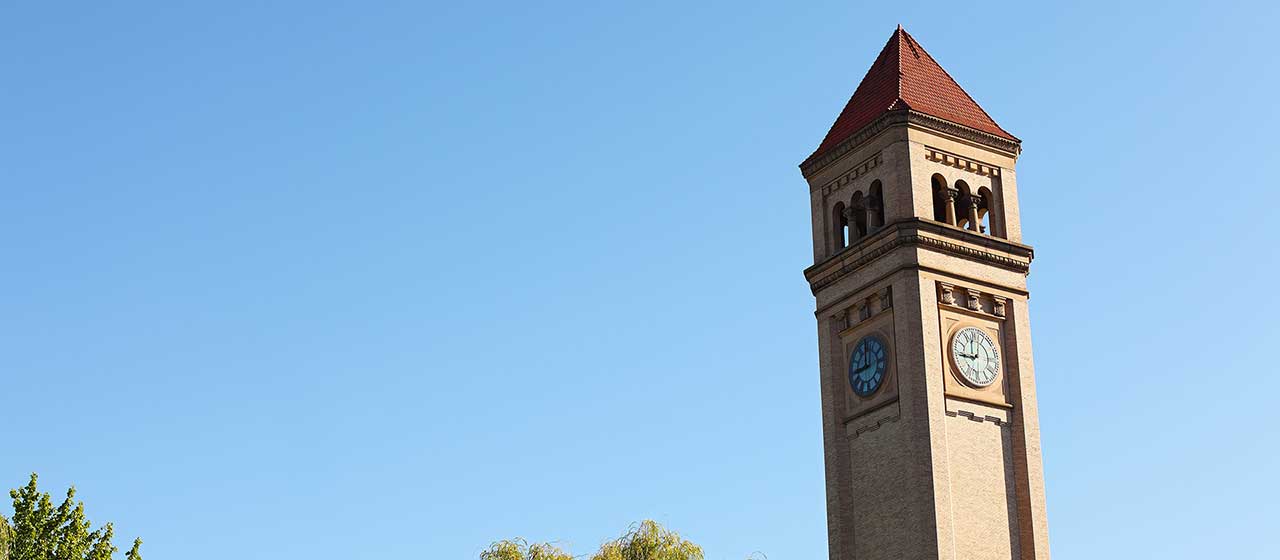
The Clock Tower on Havermale Island was originally part of the Great Northern Railroad Depot. Construction began in 1901 and finished in 1902. The depot was an impressive brick building 3 stories tall, with the monumental Clock Tower standing in at 155 feet.
The Clock Tower's South wall was part of the depot's exterior, while the lower portions of the North, East, and West walls resided in the building. If you look closely at the East and West walls (about halfway up) you will see a sloping line where the roof was originally located.
During 1972 and 1973, long after the "glory days" of train travel, the Great Northern Railroad Depot was demolished as Spokane made preparations for Expo '74. The Clock Tower was able to be preserved and serves as a reminder of Spokane's railroad history.
This 110-year-old "giant grandfather clock" is wound by hand once a week. The clockworks are housed in a small room behind the 4 clock faces. Each week, a technician climbs 5 stories to reach the clockworks. It takes 99 turns of the crank to rewind the clock.
The pendulum weighs about 200 pounds and is suspended from a thin strip of metal. The counterweights hang from cables and descend approximately 40 feet between windings. If the time needs to be adjusted, it is done from inside the clockworks room.
The clock hands on each face are attached to a shaft which connects to a U-joint in the clockworks. Each clock face measures 9 feet in diameter. At the top of every hour, the Clock Tower can be heard throughout the park. The sound of the electronic chimes is amplified through speakers in the top of the tower.
Lighting the Pavilion & Clock Tower
Is your organization or cause interested in lighting the Pavilion a specific color? Submit your request below!
Garbage Eating Goat
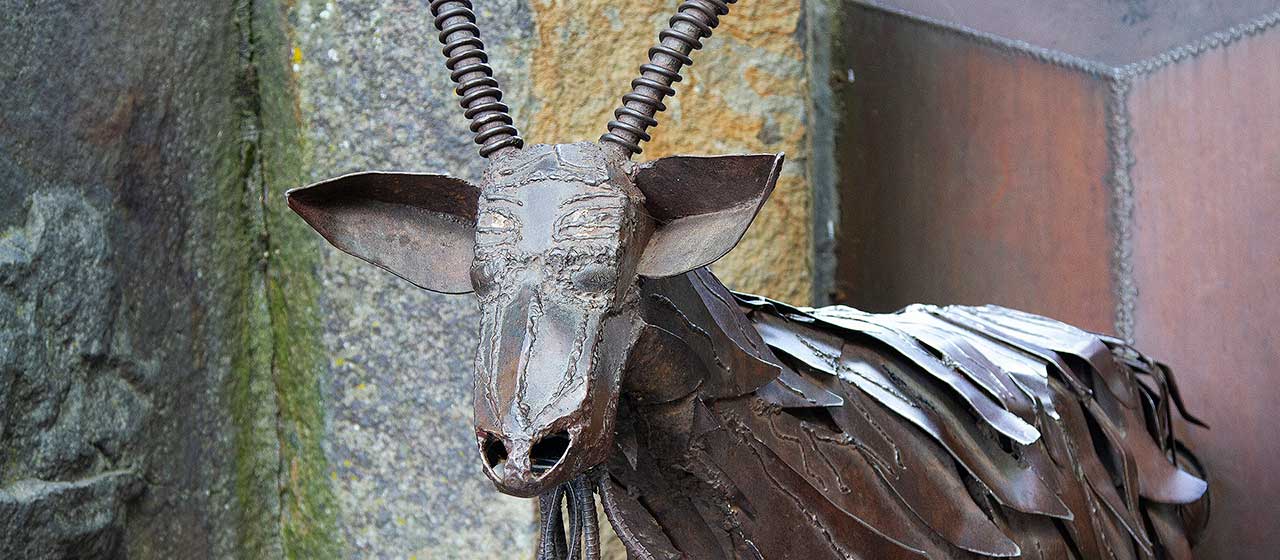
The Garbage Goat in Riverfront Park was designed by Sister Paula Turnbull, a Catholic nun, for Expo '74 as a recycling/environmental statement.
This corten steel sculpture of a goat will eat small pieces of trash with the aid of its vacuum digestive system. Don't throw your garbage on the ground, feed it to the Garbage Goat.
Havermale Island
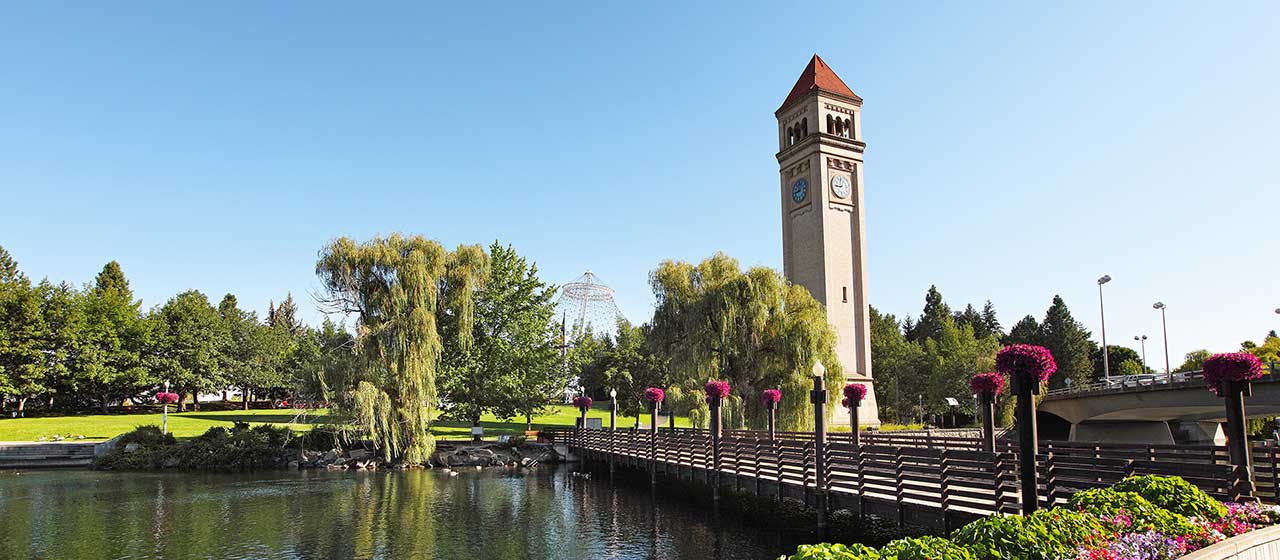
Havemale Island is located just north of the South Howard Bridge. The island was named after Reverend Samuel Havermale, an early Spokane settler. In 1877, this island was used as a pioneer stronghold during a battle with the Nez Perce Indians. Until 1974, Havermale Island was also home to the Great Northern Railroad Depot.
Pavilion
Located in the center of the park on Havermale Island, the Pavilion was originally built as the U.S. Federal Pavilion for the '74 World's Fair.
During Expo, the Pavilion consisted of an 850‑seat amphitheater with an IMAX theater within the primary Pavilion enclosure, a 17,000-square-foot central courtyard for theme exhibits that focused on environmental problems and how to address them in the daily American household, and a 5,500-square-foot Federal Action Center where you could learn more about the Federal government's approach to environmental problems.
The Pavilion had a white canvas cover during the World's Fair, but by 1978 an inverted funnel effect had caused the cover to tear so much that it was taken down, giving our Pavilion the iconic silhouette we know today.
In the years since Expo, Spokane looked to maintain the festival atmosphere by removing the amphitheater and replacing it with a petting zoo, amusement rides, an ice rink, and a 90‑minute theatrical exhibit on the history of Spokane. By the mid‑1980s, only the rides, arcade room, and ice rink remained. In the late 1980s, Mini‑Golf was added as an additional attraction.
By 2012, Riverfront Park programs that used to generate surplus revenue for the City and the Parks Department were operating at a loss. Visitors to the Park complained that the Pavilion area felt cluttered, dark and uninviting. In general, the Pavilion had much potential but was not living up to it due to inadequate funding, outdated programming, and dilapidated facilities. The Pavilion was no longer a central gathering place for Spokane or the region, despite its prominent stature within the urban landscape.
In 2014, Spokane citizens overwhelmingly approved a $64 million dollar bond to improve and redevelop the park, including restoration of the Pavilion into a flexible‑use event space.
Reopened in 2019, the redeveloped Pavilion focuses on river views, light, and shade while creating a multi‑use event space to host everything from community festivals, to arts and cultural activities, fitness classes, concerts, and graduations.
Illumination Blades
The remodeled and revitalized Pavilion features 479 high‑tech, programmable illumination blades that light up the iconic structure like a lantern, and are capable of performing dazzling light displays with various patterns and colors. The light blades vary from 3 to 6 feet in length, with a total of 2,262 linear feet of illumination. Each one foot increment of blade can be controlled separately.
Elevated Experience with River Views
Take in panoramic views of the river and downtown on the new elevated experience, an ADA accessible catwalk culminating in a viewing platform nearly 40 feet up the Pavilion mast.
Shade
Seventy two beautiful and functional panels provide increasing shade throughout the day, partially covering the Pavilion to benefit visitors during a wide range of activities while allowing for those incredible panoramic views.
Amphitheater
The previously hardscaped interior of the Pavilion now boasts 37,000 square feet of grass‑covered amphitheater‑style seating where visitors can do everything from picnicking, to yoga, to watching a national act on the new flexible use event floor of 22,000 square feet. And, of course, park goers can catch a light display under the Pavilion.
Lighting the Pavilion & Clock Tower
Is your organization or cause interested in lighting the Pavilion a specific color? Submit your request below!
Expo Exhibitor Plaques
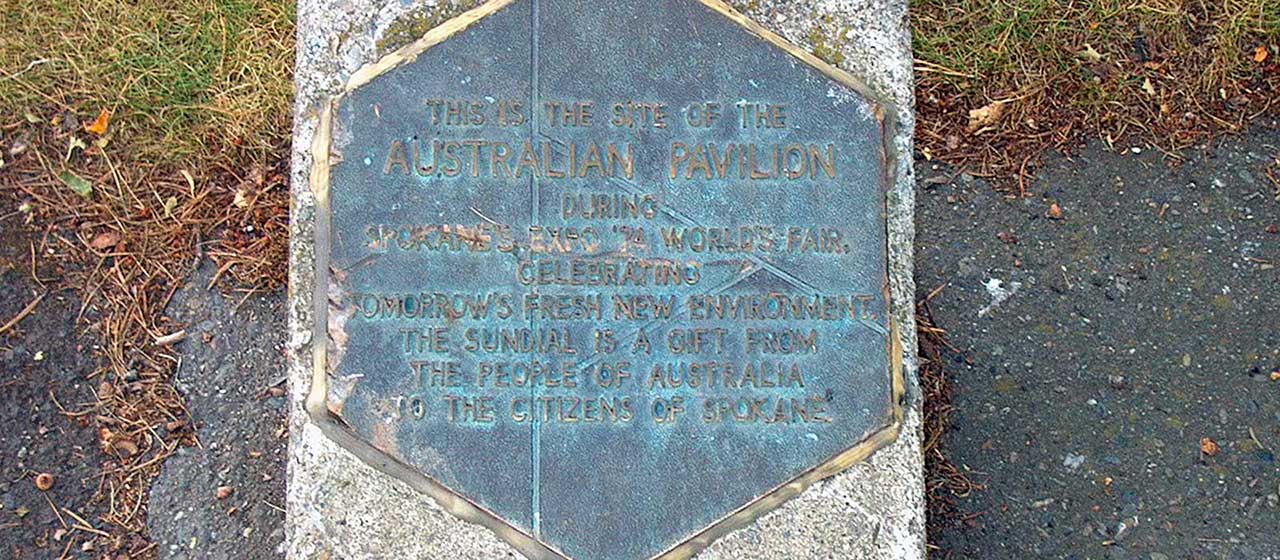
Just west of the Forestry Shelter are the plaques indicating the location of the Philippine and German exhibits. The plaque showing the location of the USSR Pavilion, which was the second largest exhibit on the Fairgrounds, is located south of the Forestry Shelter. The plaque showing the location of the Australian Pavilion is just north of the Lilac bowl. The Australian government placed the sundial there after the Fair ended. The Korean Pavilion was also in this location. The Plaza of Nations plaque is located due north of the South Howard Bridge near the Japanese Gardens. Around the outside ring you will see a list of all the countries who were exhibitors at Expo '74. The plaque on the front was placed there in 1999 honoring the 25th anniversary of the World's Fair.
Snxw Meneɂ
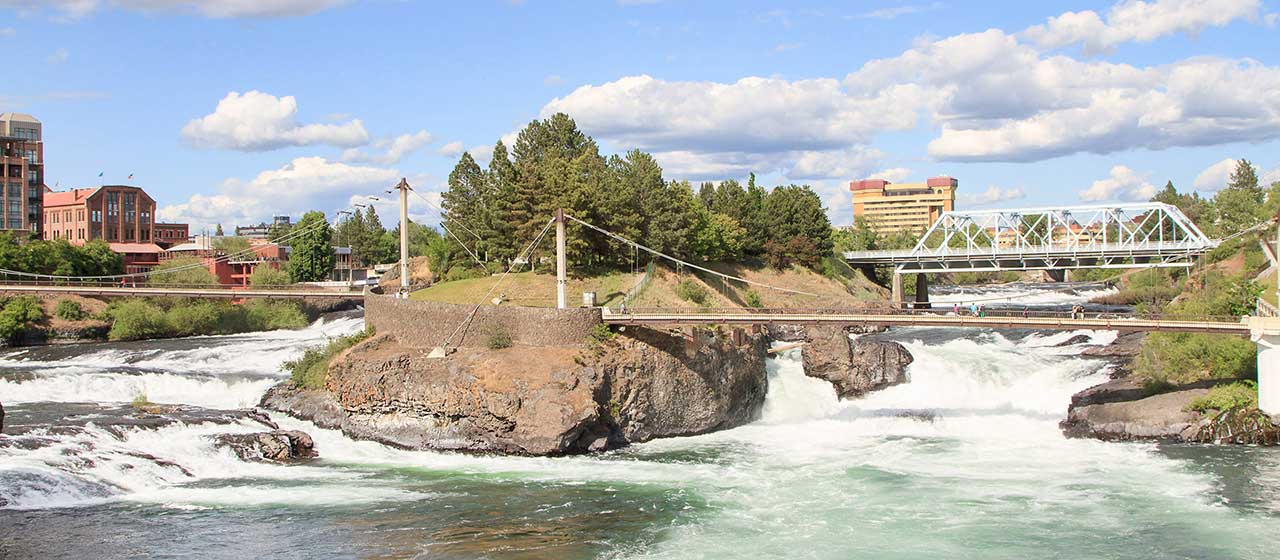
Snxw Meneɂ (sin-HOO-men-huh), formerly known as Canada Island, Crystal Island, and Cannon Island, was the location of the first water pumping plant in 1884 and is located just north of the blue bridge in the center of the Park. The main occupant of the island was the Crystal Laundry and Water Works, and you can see the brick remnants from the southern suspension bridge.
The island was renamed Canada Island in 1974 to recognize Canada's participation in – and contributions to – the Expo '74 World's Fair.
In 2016, the island was rededicated to the Spokane Tribe of Indians in acknowledgement of the sacred and historic connection between the island and the Spokane Tribe, and to recognize the symbolic importance to the tribal community. The Spokane Tribe chose to rename the island Snxw Meneɂ (sin-HOO-men-huh), meaning "salmon people" in English.
Upper Falls Power Plant
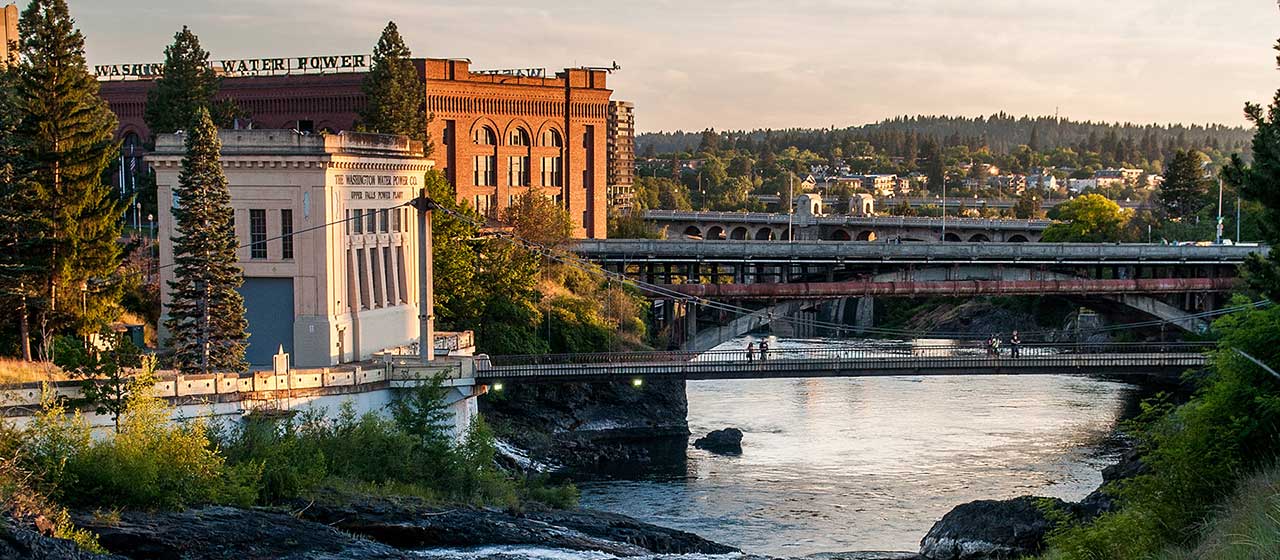
The Upper Falls Power Plant, located on the northwest side of Havermale Island near the suspension bridge, is owned by Avista Corp. They own two power plants within the park. The other one is at the base of the lower falls and can be seen from the SkyRide.
Riverfront Conservation Area
The 4.5-acre site of the former YMCA & Fire Dispatch buildings was purchased with Spokane County Conservation Futures Funding and is intended to provide passive recreation, protect and improve the water quality and natural habitat and maintain in perpetuity as open space. Specifically intended to be left in a natural state, this site also provides educational opportunities for additional conservation areas within Spokane County and provides spectacular river views and open space.












